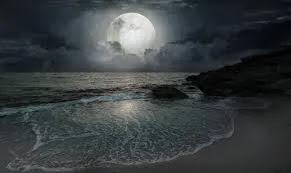The Moon's Gravitational Dance: Unraveling How it Affects Tides
Unraveling How the Moon Affects Tides
Introduction:
The moon, Earth's natural satellite, has captivated humans for centuries with its celestial beauty and mysterious influence. One of the most noticeable effects of the moon on our planet is the ebb and flow of the tides. In this blog post, we will dive deep into the fascinating relationship between the moon and tides, exploring the scientific principles behind this phenomenon and shedding light on the intricate gravitational dance that shapes our coastal landscapes.
Understanding Tides
Tides are the rise and fall of sea levels caused by the gravitational pull of celestial bodies, primarily the moon and, to a lesser extent, the sun. While the sun's gravitational force also affects tides, the moon's influence is approximately twice as strong due to its closer proximity to Earth. It's important to note that the sun's influence is more pronounced during spring tides and less during neap tides, as we will discuss later.
The Gravitational Dance
The moon's gravitational force acts on Earth and its bodies of water, resulting in the deformation of the planet's shape. This deformation creates two tidal bulges, one on the side facing the moon and another on the opposite side. These tidal bulges align with the moon, creating high tides, and occur on opposite sides of the Earth, causing low tides in between. The moon's gravitational pull causes water to be drawn towards it, giving rise to the high tide.
The Role of Centrifugal Force
While the moon's gravitational force plays a significant role in creating tides, we must also consider the centrifugal force at play. As the moon orbits the Earth, it exerts a force away from the planet, which counteracts the gravitational pull. This centrifugal force contributes to the formation of the second tidal bulge on the side of the Earth opposite the moon. The combined effects of gravitational force and centrifugal force result in the formation of two tidal bulges.
Tidal Patterns
The tidal patterns we observe on Earth are influenced by various factors, including the position of the moon relative to the Earth and the sun. When the sun, moon, and Earth align, we experience spring tides. During spring tides, the gravitational forces of the sun and moon combine, leading to higher high tides and lower low tides. Conversely, when the sun and moon are at right angles to each other, we experience neap tides. Neap tides occur during the first and third quarters of the moon, resulting in lower high tides and higher low tides.
Additional Factors
While the moon's gravitational force is the primary driver of tides, other factors can influence their magnitude and timing. The shape and depth of coastal geography, such as bays, estuaries, and channels, play a role in amplifying or dampening the effects of tidal forces. The Earth's rotation also affects the timing of tides, as each location experiences two high tides and two low tides within approximately 24 hours and 50 minutes.
Tidal variations have practical implications for coastal regions around the world. Understanding the timing and magnitude of tides is crucial for activities such as shipping, fishing, and recreational boating. Coastal engineers also take tides into account when designing structures like ports, harbors, and tidal power plants. By considering tidal fluctuations, they can ensure the safety and functionality of these structures.
Furthermore, the moon's influence on tides has implications for climate studies. Tidal patterns affect ocean currents, which play a vital role in distributing heat around the planet. Ocean currents, driven in part by tidal forces, regulate global climate systems. Changes in tidal patterns can have cascading effects on climate phenomena like El Niño and La Niña, influencing weather patterns and long-term climate variations.
Scientists and researchers continue to study the moon-tide relationship to gain a deeper understanding of this natural phenomenon. Advanced computer models and satellite observations help refine our knowledge of tidal dynamics and their interactions with other factors like weather patterns and sea level rise.
It's worth mentioning that while the moon is the primary driver of tides, the sun's gravitational force also contributes to the overall tidal effects. During specific alignments, such as during new and full moon phases, the combined gravitational pull of the sun and moon leads to higher high tides, known as spring tides. Conversely, when the sun and moon are at right angles to each other, the gravitational forces partially cancel each other out, resulting in lower high tides, known as neap tides.
As our understanding of the moon's influence on tides deepens, scientists have also begun to explore the potential impacts of future changes. Climate change and rising sea levels, for example, may interact with tidal dynamics in complex ways. The melting of polar ice caps and the expansion of ocean waters could alter coastal geography, affecting the amplitude and timing of tides in certain regions. Understanding these potential changes is crucial for coastal planning, hazard mitigation, and adapting to a changing climate.
Additionally, the study of tidal interactions extends beyond Earth. Scientists have observed similar tidal phenomena on other moons within our solar system, such as Jupiter's moon Io and Saturn's moon Enceladus. These discoveries highlight the universal nature of tidal forces and their role in shaping the dynamics of celestial bodies.
In recent years, advancements in technology have allowed for more precise measurements and observations of tidal phenomena. Satellite altimetry, for instance, provides detailed information about sea surface heights, enabling scientists to monitor and analyze global tidal patterns. Coupled with computer models, these observations contribute to our understanding of tidal dynamics and improve the accuracy of tidal predictions.
Education and public outreach are also vital in fostering a broader understanding of the moon's influence on tides. By raising awareness of this phenomenon, we can deepen the public's appreciation for the interconnectedness of Earth and the cosmos. Furthermore, providing accessible resources and educational materials can empower individuals to make informed decisions regarding coastal activities, environmental conservation, and sustainable coastal development.
In conclusion, the moon's gravitational pull is the primary driver behind the ebb and flow of tides. Its intricate dance with Earth, along with the sun's influence, creates the mesmerizing tidal patterns we observe along coastlines worldwide. The study of tides not only enhances our understanding of the natural world but also has practical applications in various fields. By unraveling the complexities of the moon's impact on tides, we gain insights into climate systems, coastal engineering, navigation, and the delicate balance of our planet's ecosystems.
As we continue to explore and appreciate the profound relationship between the moon and tides, let us marvel at the beauty of this celestial interaction and strive to protect and sustain the fragile coastal environments that are shaped by these powerful forces.
Conclusion:
The moon's influence on tides is a remarkable demonstration of the interconnectedness of celestial bodies and their impact on our planet. The intricate gravitational dance between the moon, Earth, and the sun shapes the ebb and flow of tides, sculpting our coastal landscapes and providing a habitat for diverse marine life. As we continue to explore and understand the complexities of this phenomenon, scientists can apply this knowledge to various fields, including marine navigation, coastal engineering, and climate studies.






